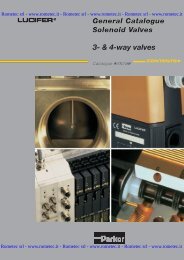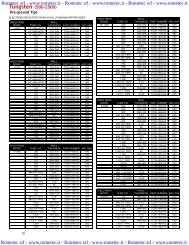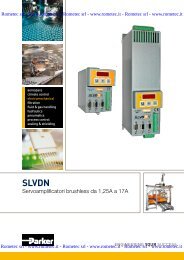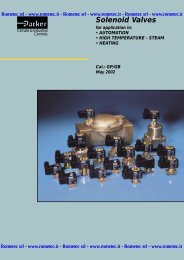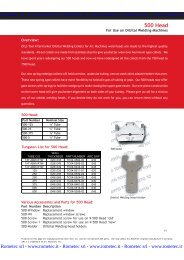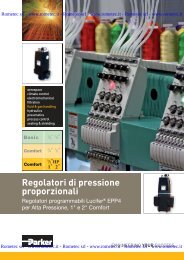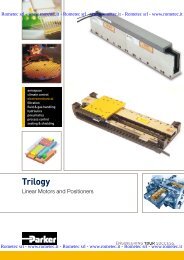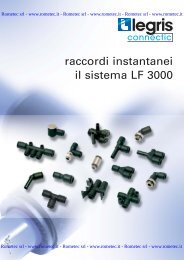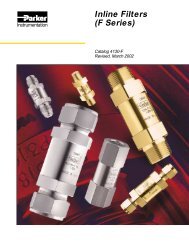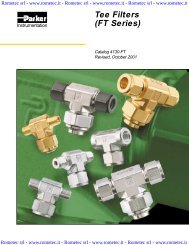Create successful ePaper yourself
Turn your PDF publications into a flip-book with our unique Google optimized e-Paper software.
<strong>Rometec</strong> <strong>srl</strong> - www.rometec.it - <strong>Rometec</strong> <strong>srl</strong> - www.rometec.it - <strong>Rometec</strong> <strong>srl</strong> - www.rometec.it<br />
<strong>Quick</strong> Coupling Products<br />
Glossary of Terms<br />
Air Inclusion<br />
The ambient atmosphere forced into the system during the<br />
connection of the quick disconnect halves.<br />
Break-Away<br />
Automatic disconnection of a coupling when an axial separation<br />
force is applied.<br />
Brinelling<br />
Dimples or grooves worn into the shoulder of a male half by the<br />
locking balls in the female half.<br />
Burst Pressure<br />
The pressure at which a device loses the capability to retain<br />
pressure.<br />
Case Hardening<br />
Hardening the surface of low carbon steel..<br />
Cold Flow<br />
Continued deformation under load.<br />
Connect Under Pressure<br />
Ability to connect coupling halves with internal line pressure<br />
applied to either both sides or one side.<br />
Coupling, Female Half<br />
Other nomenclature “coupler”, “socket”, “body”.<br />
Coupling, Male Half<br />
Other nomenclature “nipple”, “plug”, “adapter”.<br />
Coupling, <strong>Quick</strong> Disconnect<br />
A component which can quickly join or separate a fluid line<br />
without the use of tools or special devices.<br />
Differential Pressure(∆P)<br />
The difference in pressure between any two points of a system<br />
or a component.<br />
Double-Acting Sleeve.<br />
Permits push-to-connect and pull-to-disconnect convenience on<br />
implement line when female half is clamp mounted and<br />
connected with a hose.<br />
Dust Cap<br />
Dust or dirt repelling enclosure for both halves.<br />
Dust Plug<br />
Dust or dirt repelling enclosure both halves.<br />
Flow Checking.<br />
Occurs when a nipple valve closes during flow conditions, such<br />
as when quickly lowering a heavy implement. (Also called<br />
Check Off, Back Checking or Lock-up.)<br />
Flush Position (Valve)<br />
When the coupler valve is fully open, allowing maximum oil flow.<br />
Force to Connect<br />
Axial and/or rotational force required to make a complete<br />
connection.<br />
Force to Disconnect<br />
The reverse of the above.<br />
Induction Hardening.<br />
Localized hardening of medium carbon steel.<br />
Peak Pressure<br />
Maximum momentary pressure encountered in the operation of<br />
a component.<br />
Pressure Cap<br />
Cap which incorporates a seal capable of withstanding the<br />
rated pressures on the male half.<br />
Pressure Impulse Test<br />
Subjecting a component to a specified pressure at a specified<br />
rate of increase or decrease for a specified time limit.<br />
Pressure Operating<br />
The pressure at which a system is operated.<br />
Pressure Plug<br />
Plug which incorporates a seal capable of withstanding the<br />
rated pressures on the female half.<br />
Proof Pressure<br />
The non-destructive test pressure in excess of the maximum<br />
rated operating pressure.<br />
Push To Connect (Auto Lock)<br />
Locking arrangement which permits one handed connection by<br />
pushing the nipple into the coupler.<br />
Rated Pressure<br />
The maximum pressure at which a product is designed to<br />
operate.<br />
Single-Acting Sleeve<br />
Permits pull-to-disconnect convenience on implement line when<br />
female body is clamp mounted. Making connection requires<br />
manually pulling female body forward, inserting male tip, then<br />
allowing body and tip to return to original position in the clamp.<br />
Sleeve Lock<br />
Arrangement which provides an additional lock which must be<br />
actuated before the locking sleeve can be retracted.<br />
Spillage<br />
The fluid removed from the system due to disconnection of a<br />
coupling assembly. This is the fluid trapped between the mating<br />
seal and the valve seal of the coupling halves.<br />
Surge Pressure<br />
The pressure existing from surge conditions.<br />
Surge Flows<br />
A rapid increase in fluid flow.<br />
Thermal Build-Up.<br />
Hydraulic pressure caused by expansion of the fluid due to heat<br />
from an external source such as sunlight.<br />
Trapped Pressure<br />
Pressurized hydraulic fluid trapped behind closed coupling valve<br />
Twist Lock<br />
A locking arrangement which requires a rotational actuation to<br />
unlock the mating halves.<br />
Types of <strong>Quick</strong> Disconnect Coupling Valves<br />
Straight-Thru (ST)<br />
This provides straight through flow.<br />
Double Shut-off Valve (DSO)<br />
A valve in the female half and a valve in the male half.<br />
Single Shut-off Valve (SSO)<br />
Generally, a valve in the female half with no valve in the male<br />
half.<br />
46<br />
Parker Hannifin Corporation<br />
<strong>Quick</strong> Coupling Division<br />
Minneapolis, MN 55427<br />
<strong>Rometec</strong> <strong>srl</strong> - www.rometec.it - <strong>Rometec</strong> <strong>srl</strong> - www.rometec.it - <strong>Rometec</strong> <strong>srl</strong> - www.rometec.it



